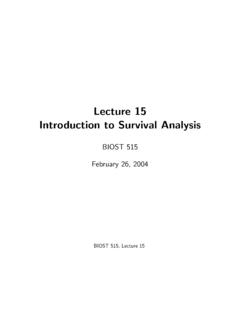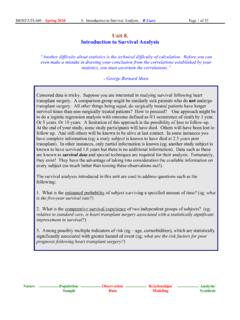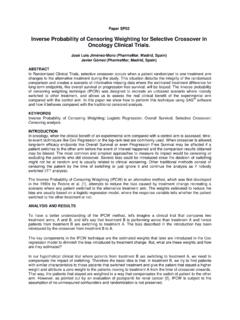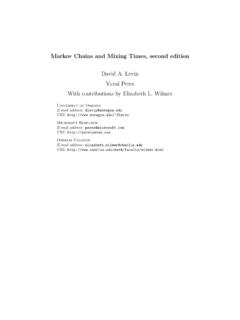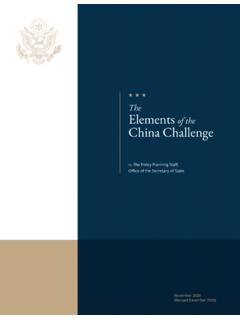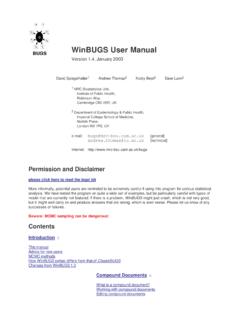Transcription of 237-2009: Analysis of Survival Data with Clustered ... - SAS
1 1 Paper 237-2009 Analysis of Survival Data with Clustered EventsLida Gharibvand, University of California, RiversideLei Liu, University of Virginia, CharlottesvilleABSTRACTTwo methods to analyzing Survival data with Clustered events are presented. The first method is a proportional hazards model which adopts a marginal approach with a working independence assumption. This model can be fitted by SAS PROC PHREG with the robust sandwich estimate option. The second method is a likelihood-based random effects (frailty) model. In the second model, the baseline hazard could be either a priori determined ( , Weibull) or approximated by piecewise constant counterpart. The estimation could be carried out by adaptive Gaussian quadrature method which is implemented in SAS PROC NLMIXED.
2 The advantages,disadvantages, and relevant situations for proper application of each model are demonstratedusing the published diabetic retinopathy data. Keywords: Survival Analysis , Cox's proportional-hazards model, Survival function, frailty model, mixed models, Gaussian quadrature estimation, PROC PHREG, and PROC Analysis is the phrase used to describe the Analysis of data in the form of times from a well-defined time origin until the occurrence of some particular event or end-point such as death. In this paper we are interested in the Analysis of multivariate failure time data. Such data arise when each study subject can potentially experience several events (for instance, multiple infections after surgery) or when there exists some natural or artificial clustering of subjects (for instance, a litter of mice) that induces dependence among the failure times of the same cluster.
3 Data in the former situation are referred to as multiple events data, which include recurrent events data as a special case; data in the latter situation are referred to as Clustered data. Two approaches are generally used in the Analysis of correlated failure time data: a marginal model approach (Wei, Lin, and Weissfeld [1], hereafter WLW) and a frailty model approach [2]. In the marginal model, WLW adopts a pseudolikelihood approach with a working independence assumption. They estimated the covariate effect assuming independence among correlated failure times, while adjusting for the correlation by sandwich estimate in estimating the covariance matrix. Frailty model is a random effects proportional hazards model.
4 The random effects could be used to capture the relation of the correlated observations in the Clustered or recurrent events are three SAS procedures available for analyzing Survival data: LIFEREG, LIFETEST and PHREG. PROC LIFEREG is a parametric regression procedure to model the distribution of Survival time with a set of concomitant variables [3]. PROC LIFETEST is a nonparametric procedure to estimate the survivor function, compare the underlying Survival curves of two or more samples [4]. PROC PHREG is a semi-parametric procedure that fits the Cox proportional hazards model [5]. These procedures can not be used directly in modeling correlated Survival data. However, with the robust sandwich estimate option, PROC PHREG can be used to perform Clustered data Analysis or recurrent data Analysis , adopting a GEE-like marginal approach.
5 This procedure will be illustrated under Model SAS, the estimation in frailty model could be carried out in PROC NLMIXED. The NLMIXED procedure fits nonlinear random effects models using MLE. Both fixed and random effects can be Statistics and Data AnalysisSASG lobalForum2009 2included the model nonlinearly [6, 7]. These models have a wide variety of applications, ,pharmacokinetics and overdispersed binomial data. PROC NLMIXED fits nonlinear mixed models by maximizing an approximation to the likelihood integrated over the random effects [5, 6]. Different integral approximations are available, the principal ones being adaptive Gaussian quadrature and a first-order Taylor series approximation.
6 A variety of alternative optimization techniques are available to carry out the maximization; the default is a dual quasi-Newton algorithm which updates the Cholesky factor of an approximate Hessian to achieve convergence [6]. Successful convergence of the optimization problem results in parameter estimates along with their approximate standard errors based on the second derivative matrix of the likelihood function. PROC NLMIXED enables the users to apply the estimated model to construct predictions of arbitrary functions by using empirical Bayes estimates of the random effects. The users can also estimate the arbitrary functions of the nonrandom parameters, and PROC NLMIXED computes their approximate standard errors by using the delta method.
7 SAS PROC NLMIXED enables the user to specify a conditional distribution for the data (given the random effects) having either a standard form (normal, binomial, Poisson) or a general distribution that the user can code using SAS programming statements. The latter feature makes it possible to fit a frailty model with either an a priori ( , Weibull) parametric baseline hazard function or a piecewise constant one. We will illustrate these two models under models 2A and 2B, DATA USEDThe three models described in this paper are applied to analyze the same dataset to be consistent: the Diabetic Retinopathy Study (DRS) dataset which is available online Diabetic retinopathy is themost common and most serious eye complication of diabetes, which may lead to poor vision oreven blindness.
8 The DRS was started in 1971 to investigate the efficacy of laser photocoagulation in delaying the onset of severe vision loss. This study enrolled 1742 patients. One eye of each patient was randomly chosen for treatment and the other eye served as an untreated control. Huster et al. [7], Therneau and Grambsch [8] both analyzed a small part of the total data, which is a 50 per cent sample of the high-risk patients (N =197).Each patient had one eye randomized to laser treatment (laser type 1=xenon, 2=argon) and the other eye received no treatment. For each eye, the event of interest was the time from initiation of treatment to the time when visual acuity dropped below 5/200 two visits in a row (defined as "blindness").
9 Thus there is a built-in lag time of approximately 6 months (visits were every 3 months). Survival times in this dataset are therefore the actual time to blindness in months, minus the minimum possible time to event ( months). censoring could be caused by death, dropout, or end of the study. Two covariates are included in the Analysis . The Treat covariate indicates an eye received laser treatment. Treat=1 indicates right eye and Treat=2 indicates left eye. The JR covariate indicates the type of diabetes with JR=1 for juvenile (age at diagnosis < 20) and JR=2 for adult. The outcome for the treated eye was compared to the untreated eye for risk groups 6-12 and Status=0 shows censored data and Status=1 shows blindness.
10 DEMONSTRATION OF MODELS FOR Analysis OF Survival DATA MODEL 1: Analysis OF Clustered DATA USING PROC MARGINAL COX MODELS FOR MULTIPLE EVENTS DATAS uppose there are i=1,2, .. ,n clusters (centers, families, litters, etc.), where each cluster hasStatistics and Data AnalysisSASG lobalForum2009 3j=1,2, .. ,J members. We record the follow-up time ijXfor each member, which is the minimum of the failure time ijDand the non-informative censoring timeijC. Denote by )(ijijijCDI the event indicator, where I(.) is the indicator function. For each member there is a covariate vector )(tZijfor fixed effects at time marginal Cox model for the jthevent and the ithcluster is given by niJjeZttZjijjijj.










